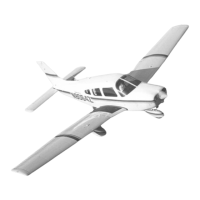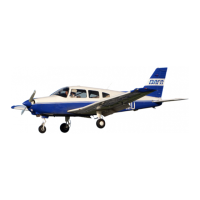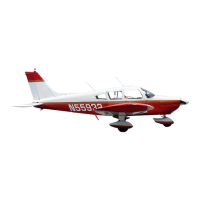PAGE 4
Nov 30/06 4C14
51-10-00
PIPER AIRCRAFT, INC.
PA-28-161, WARRIOR III
MAINTENANCE MANUAL
(2) Evaluate corrosion damage to determine type and extent of repairs required. Proceed as
follows:
(a) Light Corrosion: discoloration or pitting. Remove by light hand sanding or a small amount
of chemical treatment.
(b) Moderate Corrosion: similar to light corrosion except there is blistering or evidence of
scaling and flaking. Remove by extensive hand or mechanical sanding.
(c) Severe Corrosion: similar to moderate corrosion with severe blistering, exfoliation, scaling,
or flaking. Remove by extensive mechanical sanding or grinding.
E. Corrosion Prone Areas
Certain areas are more prone to corrosion than others. The following list is a general guide to areas
where corrosion is frequently found.
(1) Areas around steel fasteners are susceptible to corrosion. The paint on these areas cracks
which allows moisture to seep in and corrode the underlying metal. Each time the fastener is
removed, it should be coated with zinc chromate (or equivalent) before reinstallation. The paint
should be wet when the fastener is installed.
(2) Fluids tend to seep into faying surfaces, seams and joints due to capillary action. The effect of
this type of intrusion is usually detectable by irregularities in the skin’s surface.
(3) Spot welded assemblies are particularly prone to corrosion. The only means to prevent this
type of corrosion is by keeping potential moisture entry points in the spot weld filled with a
sealant or preservative compound. On an aluminum spot welded assembly, a chromate
conversion coating before paint is applied will help prevent corrosion.
(4) Areas exposed to exhaust gases may have their finish damaged by deposits. These deposits
may result in an aggressive attack on the metal by corrosion. Heat from the exhaust may also
blister or otherwise damage the paint. Gaps, seams, hinges and fairings are some places
where exhaust gas deposits may be trapped and not reached by normal cleaning methods.
(5) The wheel well and landing gear are the most exposed parts of the aircraft. Due to the
complexity of its shape, assemblies and fittings, maintaining a protective coverage is difficult.
The especially troublesome areas are:
(a) Magnesium wheels: around bolt heads, lugs and wheel well areas:
(b) Exposed rigid tubing, B-nuts, ferrules, under clamps and tubing identification tape:
(c) Exposed position indicator switches and other electrical equipment:
(d) Crevices between stiffeners, ribs and lower skin surfaces.
(6) Flaps, flight control slots and equipment installed in these areas may corrode unnoticed unless
a careful surveillance is maintained.
(7) Engine frontal areas, air inlet ducts and the leading edge of wings, because they are constantly
exposed to abrasion by dirt, dust, gravel and rain, should be checked frequently for the
beginning of corrosion.
(8) Hinges (piano hinges especially) are extremely vulnerable to corrosion. Their protective
coatings wear away and they naturally trap dirt, salt and moisture.
(9) Control cables may have bare spots in their preservative coating which will lead to corrosion.
Cables having external corrosion must be checked for internal corrosion. If internal corrosion is
present, replace the cable. If only external corrosion is present, remove corrosion with wire
brush and recoat cable with preservative.

